Do you ever wonder how modern scientists ‘read’ your genes? It’s not wizardry; it’s the revolutionary DNA sequencing technology transforming the healthcare and agriculture landscape. If you are intrigued about how things work these days, are a learner, or even a curious individual, you are in the right place.
First, we will talk about the DNA sequencing process, techniques, and the astonishing uses of DNA sequencing technology today. That is, we will explain everything in a simple conversational format, learning made easy! Let’s go!
Table of Contents
ToggleWhat is DNA Sequencing?
Now, let’s explain it. Your DNA functions similarly to a guidebook for your body, and it contains constituent parts known as four chemical bases – Adenine (A), Thymine (T), Cytosine (C), and Guanine (G). These ‘bases’ can form pairs and are repeated so that the unique genetic code for you is created.
So, what is DNA sequencing? It’s finding the precise location of one of those four bases on a strand of DNA. In simple terms, it is scanning your genetic barcode.
Once the sequence is known, we can explore your potential eye colour and predisposition to specific health conditions.
Why Does DNA Sequencing Matter?
Imagine having the ability to predict health conditions and fashion bespoke medicines. Sequencing has limitless applications, including tracing ancestry, enhancing crop yields, and protecting species from extinction. Here are some uses of DNA sequencing:
- Diagnosing genetic diseases at an earlier stage
- Formulating individualized healthcare strategies
- Researching the onset and progression of cancer
- Enhancing the quantity and quality of food
- Studying the evolution of species and their inter-relationships.
The DNA Sequencing Process Explained
The DNA sequencing process generally follows these main steps:
1) Sample Collection
The process begins with obtaining a DNA sample from blood, saliva, hair, or other biological mediums.
2) DNA Extraction
The DNA is then isolated from the cellular material. The DNA that is set aside or kept will be changed.
3) Amplification (Using PCR)
You don’t need a full genome to learn something useful. Often, only a tiny part of DNA is needed. PCR (Polymerase Chain Reaction) makes millions of copies of that small section.
4) Sequencing
Now, we read the actual sequence. That’s where different DNA sequencing techniques come into play. (We’ll get to that next.)
5) Data Analysis
After the sequence is performed, it is checked against databases to search for any existing mutations, patterns, or genes of interest.
DNA Sequencing Methods – Then and Now
In the past, when DNA sequencing started, it was slow, tedious, costly, and restrictive. Now? It is agile, economical, and exceedingly powerful.
Here are the primary DNA sequencing methods:
1) Sanger Sequencing (The Classic Way)
Sanger sequencing was the first technique to sequence entire genomes, which was developed in the 1970s. Although it is considered reliable, today, it is still best for small-scale sequencing due to time constraints.
2) Next-Generation Sequencing (NGS)
This is considered the current benchmark of DNA Sequencing. Techniques under NGS can obtain and read millions of DNA fragments simultaneously, making it excellent for big projects such as sequencing an entire human genome.
3) Third-Generation (Long-Read) Sequencing
While NGS reads DNA in small bits, long-read technologies, such as Pac Bío and Oxford Nanopore, can sequence much longer stretches of DNA. This enables better mutation and variation detection.
4) Shotgun Sequencing
It sounds extreme! This method involves breaking the DNA into random pieces, sequencing them, and using software to organize them, similar to a jigsaw puzzle.
Practical Uses of DNA Sequencing in Daily Life
At this point, we are more than pleased. The uses of DNA sequencing technology are revolutionizing world sectors. Let’s examine:
1) Medical Diagnosis & Treatment
Physicians can now utilize your DNA sequence to see which diseases you could have and even create medicines tailored for you. That is the concept of personalized medicine.
2) Cancer Research
Cancer often starts with a genetic mutation. By sequencing tumor DNA, doctors can spot what’s wrong and pick the proper treatment.
3) Forensics
DNA is frequently left behind at crime scenes. Experiments done through sequencing can link sample evidence to possible criminals or even help identify victims years after the incident.
4) Agriculture
Scientists and farmers are applying DNA sequencing techniques to improve crops by making them more nutritious, pest-resistant, and adaptable to harsh climates.
5) Animal & Plant Conservation
Conservation programs for endangered species are now made possible using DNA information. It assists in tracking the population, identifying what species, and controlling inbreeding.
6) Infectious Disease Control
Controlling an outbreak is achievable by sequencing the virus or bacteria’s genome, as it aids in understanding its mode of infection and the possible ways to stop it.
Final Thoughts
From elementary to complex applications, we have discussed so much. But the point of it all is this: a technique like DNA sequencing is not limited to the laboratory. Instead, it serves as a clue to understanding the essence of existence.
It does not matter if DNA sequencing is needed to treat some illness, develop healthier food, or reveal the history of evolution; sequencing a DNA molecule reveals information that once seemed beyond reach.
As newer methods of sequences and technological improvements are developed, this branch of study will expand with them. It is an excellent moment to participate in the learning and exploration unfolding, and become a part of the next breakthrough. What about you? Would you have your genome sequenced?




